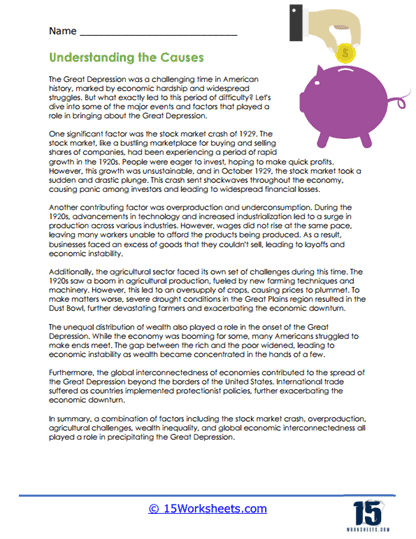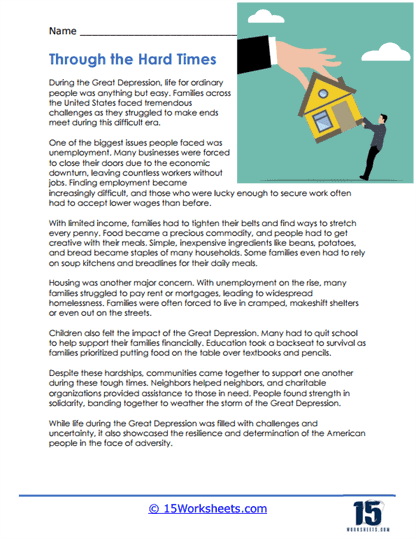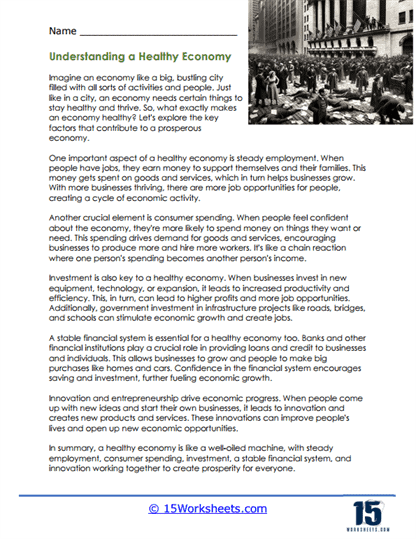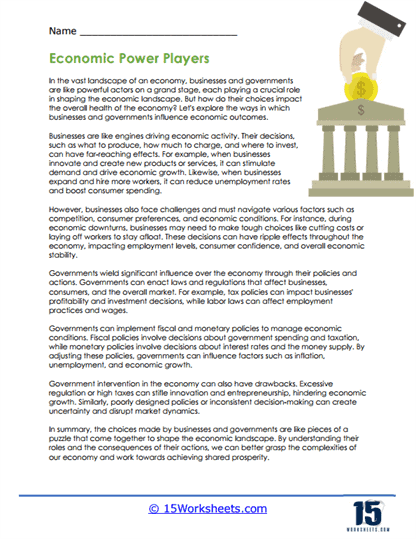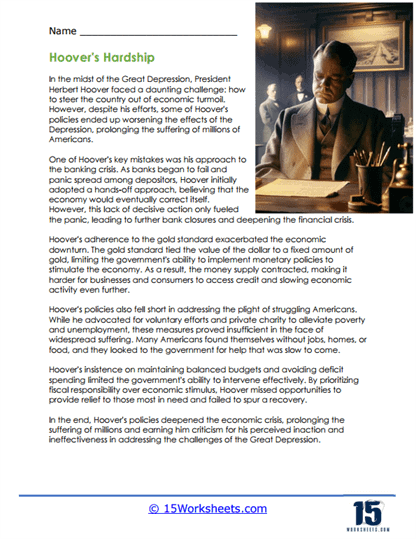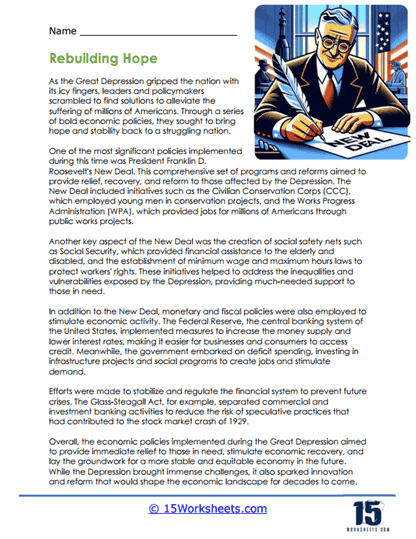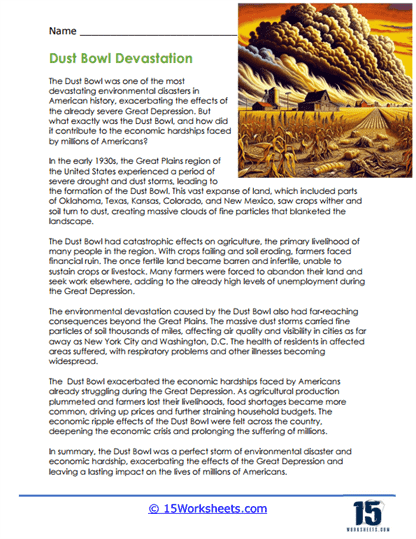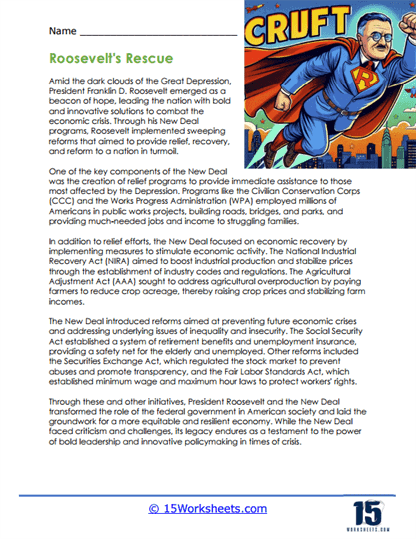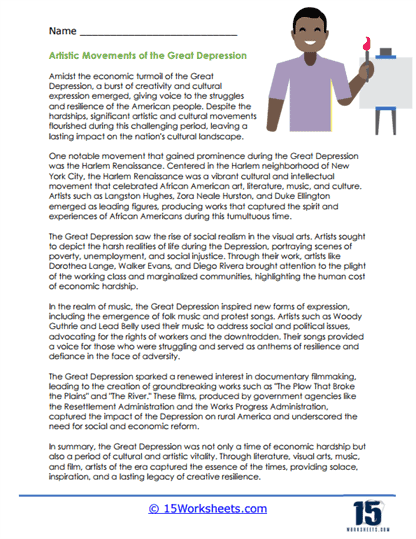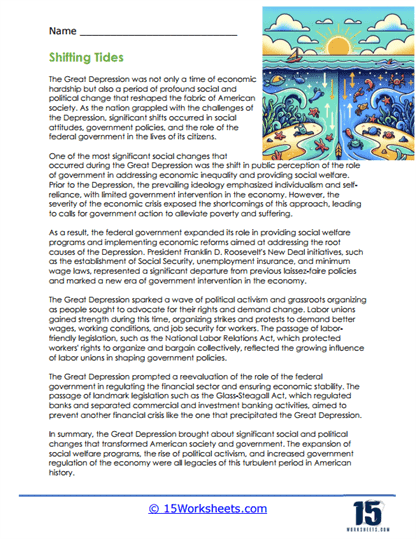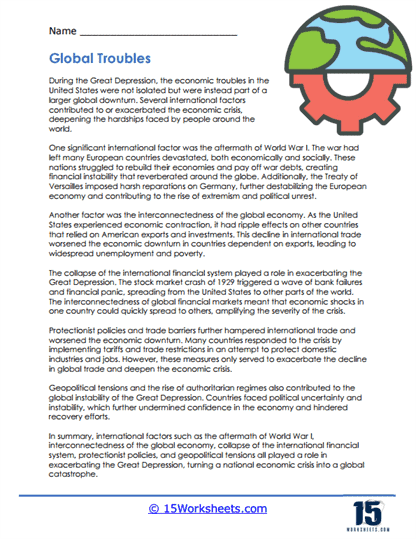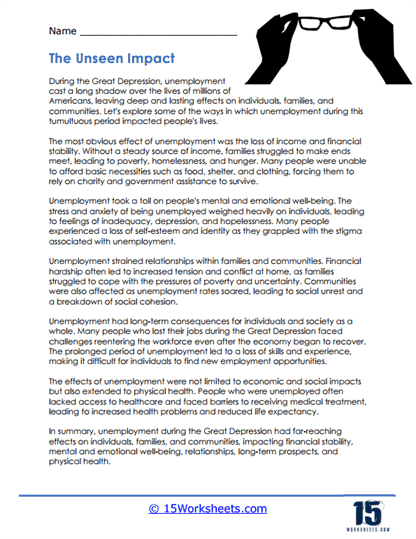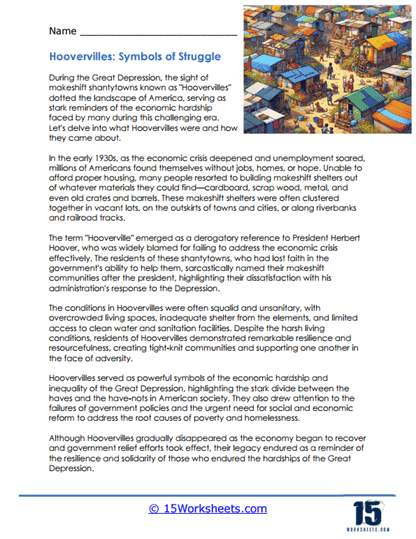Great Depression Worksheets
About These 15 Worksheets
Great Depression worksheets are educational tools designed to help students explore and understand the complexities of the Great Depression, a pivotal era in American and global history that lasted from 1929 to the early 1940s. These worksheets engage students with a variety of exercises that aim to deepen their knowledge of the economic, social, political, and cultural impacts of the Depression. By working through these materials, students can develop a comprehensive grasp of the causes, main events, responses by governments, and the broader implications of this significant period.
These worksheets make the past accessible and relevant, helping students to understand the Great Depression’s lasting influence on the modern world. Through these varied exercises, students gain a holistic view of one of the most challenging times in recent history, equipping them with the understanding necessary to analyze both past and present economic crises.
Types of Exercises
Reading Comprehension – These worksheets often start with a passage describing aspects of the Great Depression, such as the stock market crash of 1929, the widespread unemployment, or the Dust Bowl. Following the passage, students answer questions that test their understanding and encourage them to analyze the information. Questions may cover facts, infer deeper meanings, or connect causes with effects, enhancing both reading skills and historical understanding.
Document Analysis – Students examine primary sources such as photographs, government documents, personal letters, or New Deal program records. By analyzing these documents, they practice interpreting historical evidence and gain insights into the experiences of people during the Depression.
Graphs and Data Interpretation – Understanding the economic impact of the Great Depression requires analyzing statistical data. Worksheets might include graphs showing unemployment rates, GDP, stock market indices, or farm prices. Exercises require students to interpret these graphs and understand economic concepts like inflation, deflation, and economic recovery.
Comparative Analysis – Some worksheets prompt students to compare the Great Depression to other historical economic downturns, such as the 2008 financial crisis. This comparison can help students identify unique and common elements between different periods of economic distress.
Critical Thinking and Essay Writing – Prompts for essays or longer responses encourage deeper thinking about why the Great Depression occurred, its impacts on various demographics, and the effectiveness of responses like the New Deal. These exercises improve writing and analytical skills.
Creative Writing – Assignments might include writing diary entries from the perspective of a teenager during the Great Depression, creating stories based on historical facts, or scripting imaginary interviews with historical figures. This type of exercise cultivates creativity and personal engagement with the material. Some worksheets might guide students through the creation of multimedia projects, such as digital presentations, posters, or videos that summarize different aspects of the Great Depression. This helps develop technical skills alongside historical understanding.
The Benefits
Enhanced Historical Knowledge – Regularly engaging with these worksheets allows students to accumulate a robust body of knowledge about the Great Depression. This includes understanding the sequence of events, the socio-economic impacts, and the varied human experiences during this time.
Development of Critical Thinking – Analyzing primary sources, data, and the efficacy of government policies develops critical thinking skills. Students learn to evaluate sources, discern bias, and understand differing perspectives on historical events.
Improved Empathy and Cultural Awareness – Role-playing and creative writing exercises help students empathize with people from the past, understanding their struggles and hopes. This builds a deeper, more nuanced understanding of how historical events affect individuals and communities.
Preparation for Advanced Studies – The skills developed through these worksheets prepare students for more advanced historical studies and examinations. They learn to handle complex information, construct coherent narratives, and engage critically with sources. Great Depression worksheets often intersect with economics, politics, and sociology, providing a multidisciplinary approach to learning. This prepares students for real-world applications of their knowledge and broadens their academic interests.
What Was the Great Depression?
The Great Depression was the most severe and prolonged economic downturn in modern history, which began in the United States after the stock market crash of October 29, 1929, commonly known as Black Tuesday. It lasted roughly a decade, affecting not only the United States but causing significant economic distress worldwide. Its impacts were catastrophic, with unemployment soaring, production plummeting, and profound social and economic shifts taking place.
Causes
Stock Market Crash of 1929 – While not the sole cause, the stock market crash marked the beginning of the Great Depression. Speculation had driven stock prices to unsustainable levels, creating a bubble. When the bubble burst, it wiped out millions of investors.
Bank Failures – Following the stock market crash, many banks suffered significant losses, leading to about 11,000 out of the 25,000 banks nationwide going bankrupt. The failure of these banks meant that many people lost their savings, reducing consumer spending and further deepening the economic crisis.
Reduction in Purchasing Across the Board – As people lost their money and jobs, their ability to purchase goods decreased, leading to a reduction in the number of goods being produced and thus a further decline in the workforce, creating a vicious cycle of unemployment and deflation.
Drought Conditions – Known as the Dust Bowl, severe drought and poor agricultural practices led to failed crops across the American Midwest, displacing thousands of farming families and exacerbating the economic downturn.
Lack of Government Regulation – At the time, the federal government did not heavily regulate the banking sector or the stock market, contributing to risky business practices and an unstable economy.
Ending the Great Depression
The Great Depression began to wane as the United States mobilized for World War II. Increased government spending for the war effort revitalized industries, boosted employment, and led to the end of the Depression. Moreover, the war effort stimulated technological advancements and infrastructure improvements.
Government Adjustments to Prevent Future Depressions
In response to the economic calamity of the Great Depression, the U.S. government implemented significant policy changes aimed at preventing such an event from happening again. These changes focused on increasing government oversight, reforming financial systems, and establishing safety nets for the unemployed and impoverished. Key measures included:
The New Deal – President Franklin D. Roosevelt’s New Deal was a series of programs, public work projects, financial reforms, and regulations enacted in the 1930s. The New Deal included the creation of the Social Security Administration, which provided pensions for the elderly and other welfare benefits. Programs such as the Civilian Conservation Corps (CCC) and the Works Progress Administration (WPA) were aimed at providing employment.
Banking Reforms – The 1933 Glass-Steagall Act was crucial in restoring trust in the American banking system. It separated commercial and investment banking to reduce the risk of speculation with depositors’ money. The Federal Deposit Insurance Corporation (FDIC) was also created to insure deposits, which helped prevent bank runs.
Securities and Exchange Commission (SEC) – Established in 1934, the SEC was tasked with regulating the stock market and protecting investors from fraudulent practices, ensuring transparency and fairness in the financial markets.
Federal Housing Administration (FHA) – Created in 1934, the FHA facilitated home financing, improving housing standards and conditions and stabilizing the mortgage market.
Labor Relations – The Wagner Act of 1935 improved conditions for workers and prohibited unfair labor practices, providing a boost to labor unions and thus to the workers themselves.
Long-term Adjustments
Over the decades, the government has continued to refine economic policies to safeguard against economic downturns. Measures include fine-tuning monetary policies by the Federal Reserve to manage inflation and prevent significant economic bubbles. Fiscal policies have also been adjusted to manage government spending and taxation more prudently. Financial stress tests on banks, increased capital requirements, and more stringent regulatory frameworks were introduced following the 2008 financial crisis to further buffer the economy against potential crashes.



